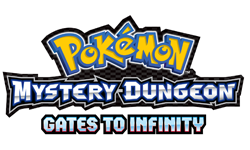|
|

|
PLATFORM
|
3DS
|
BATTLE SYSTEM
|

|
INTERACTION
|

|
ORIGINALITY
|

|
STORY
|

|
MUSIC & SOUND
|

|
VISUALS
|

|
CHALLENGE
|
Easy
|
COMPLETION TIME
|
20-40 Hours
|
|
OVERALL

|
+ Very accessible in terms of portability
+ Building Paradise is quite fun!
- Bland boring dungeon design and gameplay
- Many pointless additional features
|
Click here for scoring definitions
|
|
|
I've always been a casual Poké-fan. The series has never been able to fully sink its claws into me to the point of a Poké-obsession. Pokémon Mystery Dungeon, a spin-off of the main series, is a dungeon crawler/roguelike wherein the Pokémon must explore dungeons in search of a grand adventure. Sounds adorable, right? Well, in this latest installment, Pokémon Mystery Dungeon: Gates to Infinity, I question why I spent nearly forty hours with the game, and all I got was a sappy ending.
Gates to Infinity begins with a human who hears a voice, calling him to save the Pokémon World. With the Poké-pocalyse drawing closer, players select their avatar Pokémon and his bestfriend and begin to roam the world in search of the mysterious evil and the Magnagates that unlock new areas within the world. There's not much to the overall story, but there's something pleasant about the game's immense positivity. Everything within the plot revolves around being able to accomplish any goal one sets his mind to and showcasing the power of teamwork. As the plot begins to unravel, there's certainly one great plot twist that is mostly marred by the inane dialogue. The localization comes across sappy and saturated, so it never feels like the conflict is truly daunting because positivity triumphs over adversity. The narrative could have stood strong if it had more urgency, but this may be due to the target audience the game is structured for. While the positive messages are completely appreciated, the dialogue overdoes it to the point of annoying.
Speaking of annoyances, Gates to Infinity suffers from exceptionally poor pacing. Dialogue sections are drawn out, while the dungeon crawling sections are long, dull slogs. Although the game is accessible in the sense that players can accept request missions that can be completed in five to ten minutes and there's a quick save option, playing this game for long sessions is tedious. It doesn't help that the dungeon designs are completely uninspired and boring. It's hard to get excited about exploration when it never feels like there's anything worthwhile happening within the plot or dungeons. Gates to Infinity could have been an interesting concept if the game's gameplay and story didn't move at a snail's pace.
 Gurdurr is a lumberjack and he's okay. He sleeps all night and he works all day.
Gurdurr is a lumberjack and he's okay. He sleeps all night and he works all day.
|
|
It also doesn't help that the game is horribly easy. Although the game has moments that feel incredibly cheap, the overall difficulty is quite simple, which adds to the boredom. Considering how easy the game is, it doesn't make exploration at all enticing to the player, nor does it give good reason to keep items within the dungeons. Many of the items collected within the dungeons are fairly useless, and Pokémon recruitment occurrences are as random as the dungeons themselves. While the game sports a grid-based version of the Pokémon battle system, players are mostly bound to the type that they selected at the beginning.
While many of the Pokémon have dual-types, they can still only carry four moves at a time, and the battles still use the type and element weaknesses, which does add some variety to the overall dungeon crawling experience. However, the game also introduces the V-Wave system, wherein a new element will be randomly present when exploring the dungeons. V-Wave changes every day, and it creates new advantages and disadvantages for dungeon delving Pokémon. This feature is so unnecessary and doesn't add anything other than another layer of annoyance. It also doesn't help that this feature is also introduced by an incredibly obnoxious Pokémon.
Despite the complaints that have been outlined thus far, the game is competent for what it is, and there are some positives. When players are not dungeon delving, they can work towards building their own Pokémon Paradise, which features type dojos, item services, gardens, and other wonderful sundries. Building Paradise is by far the most interesting and exciting aspect of the game, though in order to do this, players must do the requests on the bulletin board and gather ingredients to expand the world. Unlike the story dungeons, the requests take five to ten minutes tops and are great to play in small sessions. These byte-sized requests are far more appreciated and varied compared to the story missions which drag on longer than necessary. These accessible features and additional world-building features add a nice sense of accomplishment for players, something the core game fails to offer.
In terms of graphics, Gates to Infinity is quite colourful and lively. It's great to see crisp and clear graphics, with 3D models that highlight all the cute features that Pokémon is known for. For some it might be "too cutesy" and "too adorable," but the graphics are harmless, and in fact, are sugary sweet. The only failings within the graphics come from the lack of dungeon design and the lack of detail in those areas compared to Paradise. In terms of sound the music is serviceable, but completely unremarkable. The sounds have moments that can be grating, but they're few and far between.
 It's the V-WHEEEEEEEEEEEEL!
It's the V-WHEEEEEEEEEEEEL!
|
|
Some of the additional features such as the "Discover a Magnagate" mode, wherein players use the 3DS camera on every day objects around the room to discover portals, is quite hit or miss. In my own personal experience I was only able to access one portal the few times I tried it, and even then it didn't feel like a necessary addition to the game. There's also a "Companion Mode," where players can switch from the main story party to all the Pokémon who were recruited throughout the adventure to help continue the building of Paradise. It's an interesting feature that adds to the accessibility, but it is irritating to be locked into the same four Pokémon throughout the main story. Some variety in terms of story Pokémon would have been graciously appreciated throughout the entirety of the game.
For those who enjoy dungeon crawlers in the vein of Gates to Infinity there is tons of side missions and post-game content to accomplish and enjoy. There's easily over forty hours of content to access, though considering the game's difficulty, there's not too much of a challenge unless randomization decides to play nasty games. Still, death will have players sent back to a safe area with items missing. While there are traps in the game, they become far more frequent towards the end game and they are generally not too difficult to recover from.
While I love the idea of Pokémon spin-offs that try to add a new layer of depth to the tried-and-true formula, Gates to Infinity leaves a lot to be desired. It definitely will have its audience and those who are willing to overlook many of the game's major flaws, but there are plenty of more interesting dungeon crawlers out there to explore. I adore the accessibility presented in Gates to Infinity, however there's not enough of it in terms of the main campaign to praise. Those who can stomach a bland boring adventure featuring your favourite Pokémon, look no further, but those seeking a dungeon crawler with some meat on its bones — look elsewhere.
Review Archives
|









